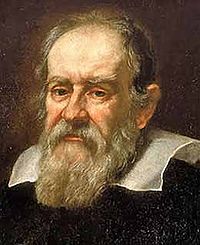Galileo Galilei
Created and completed by jlee654

Personal Life
Early Life
Galileo Galilei was born on February 15, 1564 in Pisa,Italy to Vincenzo Galilei and Giulia Ammanati. He was the first-born of six children. The Galilei's were a musical family, as Vincenzo Galilei was a famous lutenist and composer. At age 8, Galileo's family moved to Florence while Galileo stayed behind with a relative. He joined them at age 10 and was sent by his parents to a monastery at Vallombrosa. Galileo enjoyed the monk life, which did not please his father who urged him to become a medical doctor. He was eventually sent back to Pisa to enroll for a medical degree at the University of Pisa. Galileo was not particularly interested in medicine and so he became distracted by mathematics, continuing to study mathematics over his summers and eventually becoming a mathematics professor.
Family
Galileo met a Venetian woman named Maria Gamba, who he had three children with out of wedlock. He never married Maria and worried that his two daughters would never marry as well so he entered them into a convent. His son's birth eventually became a successful musician.
Death
Galileo died on January 8, 1642 in Arcetri, Italy from a fever and heart palpitations. Although the church banned works supporting the Copernican theory, they eventually lifted those bans and became accepting of heliocentrism. In the 20th century, many popes acknowledged Galileo's work as revolutionary and critical to modern science, earning him the title "The Father of Modern Science."
Inventions
Thermoscope
The thermoscope was an early version of a thermometer. The device was a small vase filled with water attached to a thin, vertical pipe with a large, empty glass ball on top. Changes in temperature of the ball would exert positive or negative pressure on the water within the pipe, causing it to rise and fall.
Telescope
Although Galileo did not invent the telescope, he greatly improved it. Initially, telescopes were only capable of up to 3x magnification, but Galileo made them magnify up to 30x.
Pendulum Clock
Upon discovering that the period of oscillation of a pendulum was not affected by amplitude, Galileo replaced the mechanism that previous clocks used with a pendulum to improve their consistency and accuracy.
Hydrostatic Balance
The Hydrostatic Balance was a balance that could determine the specific gravity of an object, typically gemstones. It determined the density of the stones by comparing their weight in water and in air.
Contributions and Discoveries in Physics and Astronomy
Nature of Pendulums
At age 19, Galileo discovered the nature of the pendulum. He timed a swinging lamp by means of his own pulse and found the period of the pendulum to be the same despite changes in amplitude, which he later verified by experiment.
Kinematics
Galileo concluded that falling objects have a uniform acceleration in a vacuum. Contrary to popular belief, Galileo was not the one who conducted the experiment of dropping two balls off of the Leaning Tower of Pisa. He also proposed that objects maintain their velocity unless acted on by a force, introducing the idea of Frictional Force.
Earth's and Jupiter's Moon(s)
Using his improved telescope, Galileo observed that the moon's surface was not smooth as everyone believed it to be, but had craters and mountains. He also saw that Jupiter had four moons in its orbit, which further enforced his views of heliocentrism.
Sun Spots
Although Galileo was not the first to observe sunspots, his observations provided more concrete evidence of them. He noticed how sunspots change shapes and seem to move across the sun slower on the edges, leading him to believe that they must reside near the surface of the sun. These observations dismissed the previous theories of sunspots just being planets moving across the sun. Galileo's observations of the sun probably had something to do with him becoming blind later.
Heliocentrism Controversy
Galileo was a supporter of Heliocentrism/Copernicanism - the idea that the sun was the center of the solar system, not the earth. He was persecuted for his theories because they contradicted Christian scripture, and so he tried to keep them less public. It was not until much later when he wrote a novel summarizing his studies 40 years prior (earning the praise of Albert Einstein), that the idea of Heliocentrism became accepted.
The Milky Way
It had been proposed that the Milky Way was a large collection of stars, but Galileo was the first to observe, through his telescope, the countless individual stars that made up the Milky Way.
See also
Further reading
Galilei, Two New Sciences, 1638
Fermi, Bernardini, Galileo and the Scientific Revolution, 1961
Reston, Galileo: A Life, 2005
External links
http://www.history.com/topics/galileo-galilei
https://thescienceclassroom.wikispaces.com/Galileo+Galilei
http://classroom.synonym.com/galileo-galileis-invention-contributions-23437.html
References
http://galileogalilei4444.weebly.com/major-accomplishmentsinventionsdiscoveries.html
http://solar-center.stanford.edu/sunspots/galileo1.html
http://www.telegraph.co.uk/technology/5115916/How-Galileo-brought-the-stars-down-to-Earth.html
http://www.biography.com/people/galileo-9305220#death-and-legacy
http://ircamera.as.arizona.edu/NatSci102/NatSci102/lectures/galileo.htm